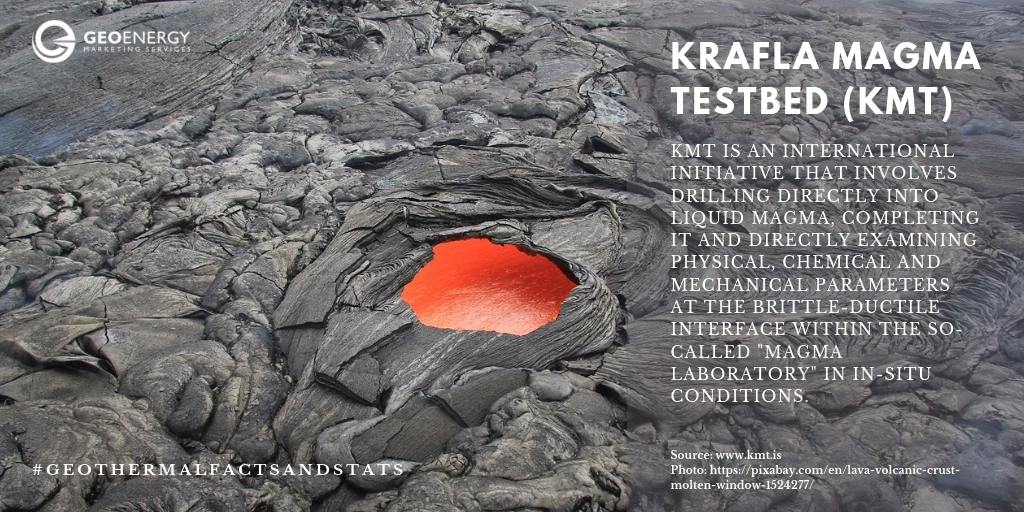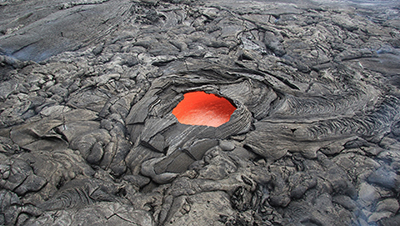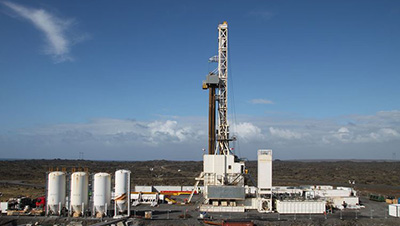Geothermal drilling in the Krafla volcano in northern Iceland has confirmed the presence of rhyolite, liquid magma with a temperature of more than 900°C at a shallow depth of approximately 2100 m during the first Iceland Deep Drilling Project (IDDP). The geothermal waters, exploited from a reservoir of high permeability, had temperatures on the wellhead of more than 450°C. The fragments of freshly quenched magma, in the form of glass, were recovered from the well during drilling. The IDDP-1 project did not envision drilling through the magma resource, but only exploring the supercritical waters just above the magma chamber at 4 to 5 km depth. However, the history of the IDDP-1 well has shown that current technology allows us to access magma resources in a fairly safe way, without a potential eruption. The results of IDDP-1 research well did not satisfy the desires of volcanologists and researchers of magma geothermal systems, which gave rise to the Krafla Magma Testbed (KMT) project. KMT is an international initiative that involves drilling directly into liquid magma, completing it and directly examining physical, chemical and mechanical parameters at the brittle-ductile interface within the so-called “magma laboratory” in in-situ conditions.
 Among other things, the main objectives of this ambitious undertaking are as follows:
Among other things, the main objectives of this ambitious undertaking are as follows:
- Monitoring of volcanic processes
Drilling to the boundary between brittle rock and ductile magma will allow investigating, among other things, where and under what conditions magma is stored under the surface of the earth. The monitoring systems potentially introduced into the well will allow for constant measurement of temperatures, crystallization, changes in gas content as well as pressure increase.
- Increasing the potential of geothermal energy utilization
Geothermal energy is an environmentally friendly and renewable source of heat and electricity, regardless of weather conditions. KMT will greatly help in the development of geothermal energy by producing electricity directly from the magma resource, at the same time increasing the productivity and efficiency of electricity conversion two or even three times, compared to conventional geothermal systems operating e.g. in doublet systems.
- Development and improvements of geothermal drilling technology and knowledge transfer
KMT will provide an opportunity to test the technological limits of materials and equipment currently used within the geothermal industry for drilling, completing and testing of wells and monitoring systems. The project also aims to commercialize the technology of electricity production from supercritical fluids. One of the additional advantages of the KMT project is the promotion of geothermal energy in the international arena and the creation of a platform that will allow tourists, students, and scientists to get to know in detail how geothermal systems work. KMT will also be an excellent training place for experts from all over the world, and above all for countries where geothermal energy has not yet reached its full potential.

Fig. 1. Simplified diagram of the geothermal reservoir at Krafla volcano (northern Iceland) and the IDDP-1 well (Friðleifsson G.O., 2007)

Fig. 2. The IDDP-1 well during production testing between 2010 and 2012; grey smoke signals casing corrosion caused by the aggressive influence of hot geothermal waters (Friðleifsson G.O., 2015)
For more #GeothermalFactsandStats like this, continue reading our blog and follow us on all the major social media platforms.
Author: Michal Kruszewski
Source: www.kmt.is
#Geothermal #Krafla #Magma #Testbed #drilling #Iceland #volcano #hightemperature


